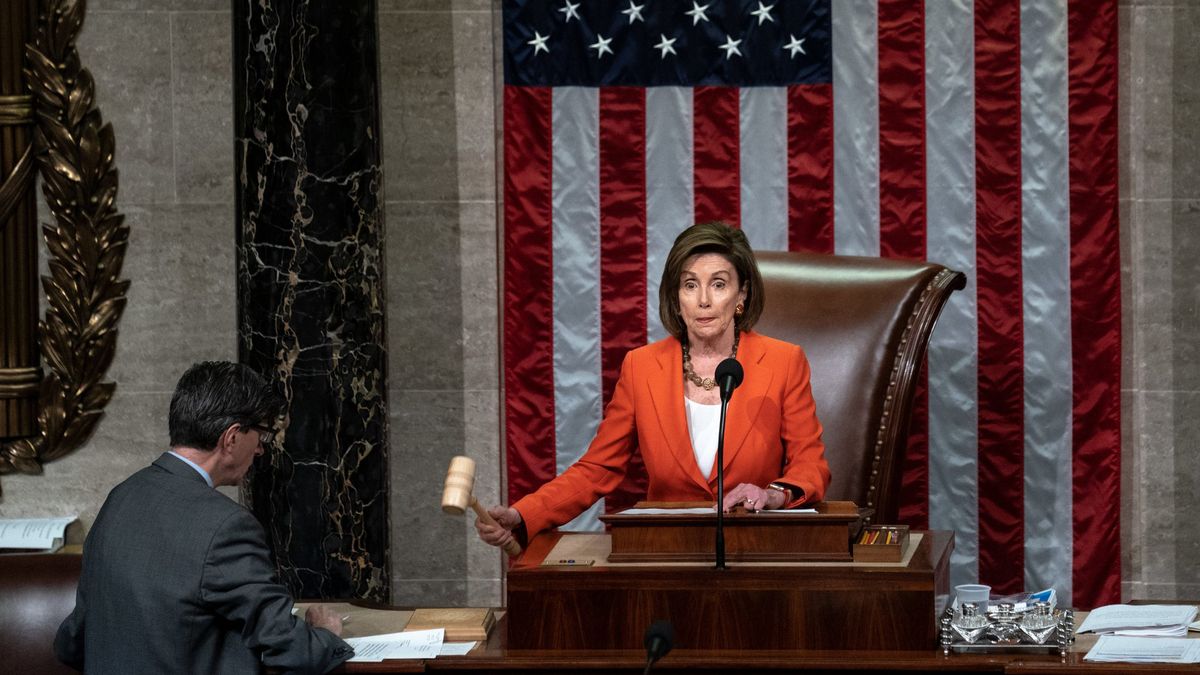US House of Representatives passes impeachment resolution

A few minutes every morning is all you need.
Stay up to date on the world's Headlines and Human Stories. It's fun, it's factual, it's fluff-free.
Members of the US House of Representatives passed a resolution on October 31 to proceed with the impeachment inquiry against President Donald Trump. The resolution sets out the rules and procedures for the next stage of the Democratic-led impeachment inquiry.
Details of the vote
President Trump faces an impeachment inquiry after a whistleblower made an official complaint alleging the president sought to coerce Ukraine into interfering with the 2020 election. The whistleblower alleges that the president wanted the Ukraine leader, Volodymyr Zelensky, to investigate and dig up damaging information on the Democratic presidential candidate Joe Biden.
After weeks of congressional investigators conducting private interviews with witnesses about alleged presidential misconduct, a resolution to formalize impeachment proceedings was brought before the House on October 31.
The House approved the resolution by 232 votes to 196. The voting was primarily along party lines, with only two Democrats, Rep Collin Peterson and Rep Jeff Van Drew, who represent districts that President Trump won in the 2016 election, voting against the motion. Every Republican member of the House opposed the resolution. The sole independent member of the House, Justin Amash, who left the Republican Party in July 2019, voted alongside the majority of his Democratic colleagues in support of the resolution.
The vote was not about impeaching Trump. Instead, the resolution specifies how the inquiry will proceed into its next phase. The resolution also outlines the rights and procedures of the inquiry, which includes the presentation of evidence for public consumption. Additionally, it details the rights of the president’s legal team and how the president can mount a defense.
This resolution has few historical precedents. The vote was only the third time in modern US history that the House of Representatives had voted upon an impeachment inquiry against a sitting president.
[article_ad]
What will happen next?
Before the vote, the House Intelligence, Foreign Affairs, and Oversight Committees have been conducting interviews with former and current Trump administration officials. These interviews have been behind closed doors and are part of the impeachment inquiry. They are aimed at gathering facts and evidence before proceeding with the public stage of the inquiry.
Republicans have labeled these interviews as secretive, but the behind closed doors nature of the interviews is typical of congressional investigations.
After the passing of the resolution, the impeachment investigation will now enter the public phase. This is something the Republicans have called for since the onset of the investigation in September.
Stated within the resolution is that the House Intelligence Committee will conduct public hearings. The resolution also lays out how the House Judiciary Committee will report any conclusions or recommendations about impeachment to the House of Representatives.
In both the House Intelligence and Judiciary hearings, previously confidential witness testimony will be released to the public.
The Republicans, the minority in the House of Representatives, will have the opportunity to call witnesses during the investigation. They will also be able to submit subpoenas. However, Democrats will need to approve these requests.
Following the public hearings, the House Intelligence Committee will write a report that sets forth its findings and any recommendations that should follow.
[article_ad]
Reaction to the passing of the resolution
The passing of the resolution means the impeachment inquiry has reached a new, irreversible phase. The decision to vote on the resolution is the most trenchant sign yet that Democrats are willing to bring a full-fledged impeachment case against the president.
After initially being reluctant and acting with caution about impeaching the president, despite repeated calls to do so, House Speaker Nancy Pelosi, the most senior elected Democrat, said that the procedures incorporated into the resolution would allow lawmakers to decide about impeaching Trump “based on the truth.”
Referencing the unequivocal and virulent opposition displayed by the Republican party, Pelosi added, “I don’t know why the Republicans are afraid of the truth.”
This sentiment was not shared by House Republican leader Kevin McCarthy. The impeachment proceedings are taking place approximately a year before the 2020 election. McCarthy argued that the Democrats are trying to remove Trump from office by impeachment “because they are scared they cannot defeat him at the ballot box” in next year’s election.
Minutes after the vote, White House Press Secretary Stephanie Grisha denounced what she labeled “a sham impeachment” and “a blatantly partisan attempt to destroy the president.” In a statement, she added, “The president has done nothing wrong, and the Democrats know it.”
President Trump reacted on Twitter by saying it is “The greatest witch hunt in American history!”
Alongside calling the impeachment inquiry a “witch hunt,” President Trump also claimed that the impeachment process would “backfire.” Writing on Twitter, the president said that the public could see “how unfair this process is" and that it would result in the Democrats losing control of the House of Representatives in the 2020 election, which they gained in the midterm elections of 2018.
However, opinion polls indicate that the impeachment of President Trump is supported by almost half of the country. In battleground states that are instrumental to the president’s reelection chances, polling found that the impeachment inquiry has broad support. Trump won Arizona, Michigan, North Carolina, Pennsylvania, and Wisconsin in the 2016 election. A poll released by the New York Times/Siena College shows that over 50% of voters in these key states support the impeachment inquiry.
Despite the impeachment inquiry, Trump’s support within the Republican party remains robust. A poll conducted by the Washington Post found that 74% of Republicans approve of Trump’s performance as president.
Why is Trump facing an impeachment inquiry?
The case for impeachment was first brought against the president after a whistleblower, believed to be a member of the US intelligence community, expressed concern over a “troubling promise” made by President Trump during a telephone conversation with Ukranian President Volodymyr Zelensky.
A rough transcript of the call later revealed that President Trump had pressed the Ukranian President to investigate former US Vice President Joe Biden. At the time of the call, Biden was the frontrunner for the Democratic nomination for president in the 2020 election.
In a formal complaint filed on August 12, the whistleblower acknowledged that they were not a direct witness to the call. Instead, the whistleblower claimed that other officials had also corroborated the account and painted a consistent picture of the telephone conversation between Trump and Zelensky.
The whistleblower’s complaint alleges the president used “the power of his office to solicit interference from a foreign country.” They also affirm that White House officials were “deeply disturbed" by the call and acted to “lockdown" all details of the conversation between the two leaders.
The call occurred in the days following Trump’s decision to block $391 million in military aid to Ukraine. Critics say the phone call is evidence that Trump acted illegally by seeking the help of a foreign nation to undermine a political rival. A senior official later testified that the release of the aid was conditional on Ukraine investigating Joe Biden.
Trump has denied any wrongdoing. The president has, in turn, accused Biden of using the power of his office to encourage the firing of Ukraine’s most senior prosecutor. Trump has alleged this was because the prosecutor was investigating an energy company that employed Hunter Biden, the son of the former Vice President.
[article_ad]




Comments ()